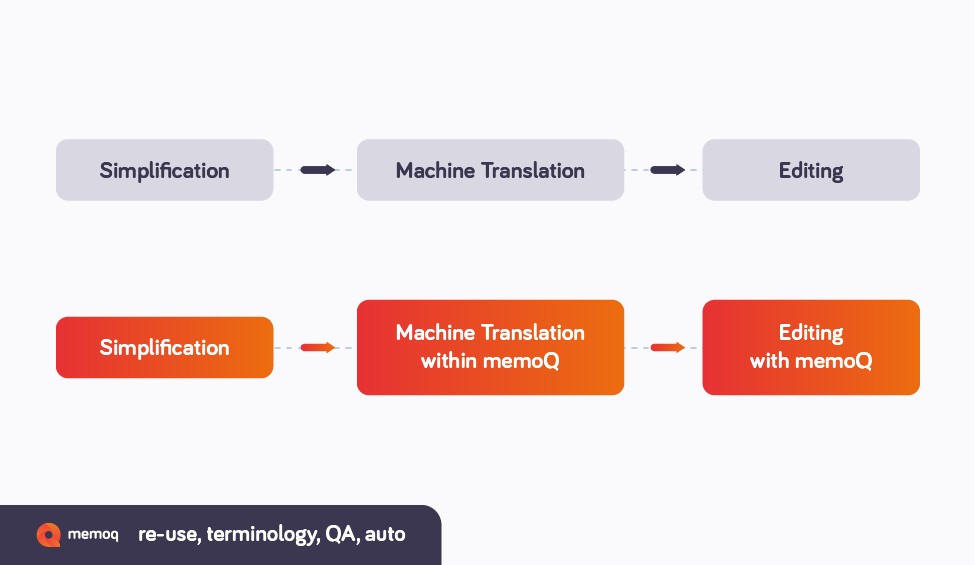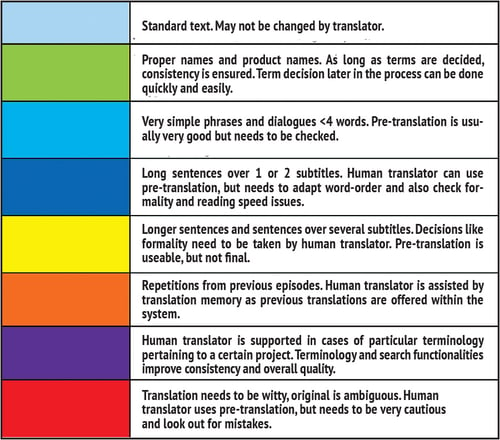The subtitling industry is buzzing about new artificial intelligence (AI) technologies that facilitate the preprocessing and simplification of subtitles. Subtitles can be more easily edited with AI and results from machine translation are improved. These exciting developments will help the media industry deal with increasing time pressure and the lack of linguistic talent for many languages. memoQ has provided leading translation technology to the language industry since 2006. It offers a TMS system with the newest technologies, like MT integration and voice recognition, right at your fingertips, allowing you to use smart translation support when you need it.
Better, faster, more: Where would audiovisual translation be without technology?
Let’s have a look at the latest developments in audiovisual translation. How do they work, and how does memoQ use similar language technology to contribute to the success of companies like yours in the media industry?

A simplified language for translating subtitles
Simplified language is not new in the translation industry. In technical documentation, we sometimes call it controlled language. It means that the author of a source text uses simple phrases, predefined terms, and reduced structures as much as possible. This makes a text easier to work on in the translation process.
Simplified language has many advantages for both the reader and the process of creating translated subtitles.
- Limited vocabulary. Neither source nor target text contain difficult or ambiguous terms.
- Reduced language structures, short sentences. Readers can understand shorter sentences and limited vocabulary faster (this is a big advantage for fast-moving subtitles!).
- Enhanced access and clarity for anybody, whether the content is for people with disabilities, children, or language learners. Short and sweet subtitles make film viewing possible for a larger audience.
- Short, well-rounded source documents. We have seen proven results in technical documentation: the work of human translators is easier and faster.
- Compatibility with computer-assisted translation, like with memoQ, and machine translation.
Simplification has clear advantages–not only from a translation technology point of view. Readability and understanding are improved for any reader. This is particularly relevant for subtitling, when people speak so quickly that everything can’t be included in the subtitle.
Subtitles: A condensed version of the original
Part of the work of a subtitler is to truncate, to make the words fit into (usually) two lines with 42 or fewer characters and within the limits of the given reading speed. Truncating can be challenging for the human subtitle translator, especially when people say a lot in a very short time. The subtitler decides where text can be shortened without losing too much of the „flavor“ of the original language. A positive side-effect of truncation: Simplification often also improves the accessibility for anybody who has difficulty reading and understanding subtitles.
To the point, or missing it? Subtitles in pivot translations
In pivot translations (translation into the target language via an intermediate language, most often English), we already see a lot of simplification occurring because of the double translation process.
When working with less common language combinations, a linguist, usually a native in the source language, creates the subtitles in English. The subtitles are then translated into one or more target languages by people who do not usually speak the original source language. The subtitle translator thus needs to rely on the skills of the person creating the template to give them all the information they need. This can be particularly challenging with cultural differences like formality, relationships (calling people „aunt“ or „uncle“ as a sign of respect or as family members), humor, figurative speech, etc.
These are significant challenges for subtitle translators, to be sure. But, if you take a close look at subtitle content, the ambiguous parts in most films or series are usually only a small portion of the total content.
The following section is excerpted from an article that first appeared in the July/August 2019 issue of MultiLingual. It is useful for visualizing leverage in audiovisual translation.
Subtitle translation in eight colors
This analysis shows the exceptional leverage translation technologies can bring for AV translation. Our examples are the first subtitles for the first nine episodes of an Asian soap opera translated for Netflix (I will not give you any details for confidentiality reasons).
Every individual episode has a duration of about 45 minutes, approximately 600 subtitles and somewhere between 2500 and 3500 words.
In our example, every column is an episode, every individual box is a subtitle. Thus we see about 50 subtitles per episode, a total of 450 subtitles. As usually, the source template has been created in English, while the source language is in an Asian language. (Working with pivot languages is common, subtitles are rarely created by the actual translator of a program. Most AV projects are translated into several languages, and thus the time-consuming template-creation process needs to be done only once).
I have color-coded every single box in order to demonstrate the possible leverage of the use of translation technologies (translation memory and machine translation) for similar subtitle projects.

The main criteria here were the structure of subtitle text in the source language. I am interested in the question how simple or complicated the source material is – as this offers a good indication for the possibilities of re-use with Translation Memory and Machine Translation (I am using the DeepL-plugin for memoQ, which works extremely well for my target language German).
In order to estimate the usability of TM and MT technologies for subtitles, I have found the following categories to be useful:

Standard text. May not be changed by translator. This standard text is required by the client and recurring between projects . There is a standard translation available for all target languages, or the translation becomes the standard translation over the course of the translation.
Example: A NETFLIX ORIGINAL SERIES, Previously on…, Subtitle translation by…
Proper names and product names. As long as terms are fixed, consistency is ensured. Term decision later in the process can be done quickly and easily. Subtitles marked in green ONLY contain names.
Example: Mom, Dad, the Doctor, Mr. and Mrs. Smith
Very simple phrases and dialogues <4 words. Automated pretranslation / Machine Translation is usually very good but needs to be checked. Reading speed issues are usually minimal due to the short total length of the subtitle.
Example: Yes. Good-bye. Okay. Wait! What is it, Susie? How is it?
Long sentences over 1 or 2 ST. Human translator can use pretranslation / Machine Translation, but needs to adapt word-order and also check formality and reading speed issues.
(Line breaks are indicated by [/], subtitle breaks are indicated by [//])
Example: There's a satellite /call for you. // Trust me, buddy./You want to take this call. (Titanic)
For me, food means //art and imagination. It should be more // than just something to eat.
Longer sentences and sentences over several subtitles. Decisions like formality need to be taken by human translator. Pretranslation is useable, but not final. Massive changes of word order might be required for a grammatically correct translation in the target language. [… is usually only used when the speaker comes to a halt, not for normal breaks between lines.
Example: Should this have/remained unseen // at the bottom of the/ocean for eternity... // ...when we can see/and enjoy it now? (Titanic)
Repetitions or recap from previous episodes. Human translator is assisted by Translation Memory as previous translations are offered within the system. This is currently a task done manually by translator and technical staff, and therefore rather time-consuming. Consistency can be much easier achieved, even if reading speed issues might give different results between individual episodes.
Terminology. Incidences of particular terminology. Human translator is supported in cases of particular terminology pertaining to a certain project. Terminology and search functionalities within the translation environment improve consistency and overall quality. Machine translation offers remarkable results for generally established terms.
Example: Medical (medical drama), culinary terms (cooking shows), military (history series), sports
„Triage is one of the most important tools a doctor has.“ (Grey’s Anatomy)
Difficult or ambiguous source material. Translation needs to be witty, original might be ambiguous. Human translator uses pre-translation or MT, but needs to be very cautious and look out for mistakes. Mistakes can distort meaning. This is particularly critical when colloquial language is translated using Machine Translation.
Example: Anything with particular or idiomatic language and style. Comedy. Reality shows.
„Blow a kiss and sashay away.“ (RuPauls Drag Show)
Lots of leverage: Look for green and blue
If you look at the example again, you will see that everything in green and blue offers the best leverage when translation memories and machine translation are used. It might come as a surprise how many simple words and phrases (in green and blue) are actually part of the sample translation. But remember: Subtitles are a written representation of spoken texts, and these texts are mostly words spoken between people. People often speak in a rather simple way with each other, and this is what we see in the dialogues we translate for subtitling. And, this is where we should definitely consider using translation technologies.
Of course, not all subtitled material is an Asian soap opera, and might not be equally suited for re-use. And it is important to understand that different aspects of language technologies might be useful for different projects.
Enhance your audiovisual translation processes with memoQ
We have seen in the past months, for example with successful international films like Parasite, that subtitling is a great way to make audiovisual material accessible to more people than we ever thought possible. The media localization industry has become crucial in keeping people world-wide entertained, trained, informed, and connected. It would be irresponsible, and not only from a business perspective, to do this without taking advantage of available technology to enable doing more in less time.
As large media companies roll out their proprietary AI-driven translation systems, memoQ is your reliable partner for the same up-to-date translation technologies to use in your company. memoQ offers smart language tools and project management that, while originally developed primarily for technical documentation, can be used for any kind of file.
memoQ offers translation tools that can help your audiovisual translation company be successful in this highly technical, time- and cost-sensitive market.
Want to read more about Audiovisual Translation in memoQ?

Angela Starkmann
Linguist, editor, PM and communication specialist with broad experience in software and documentation localization, translation of marketing material.





